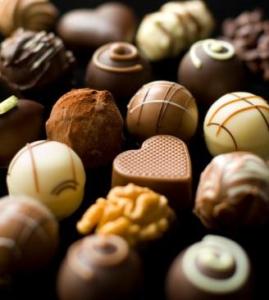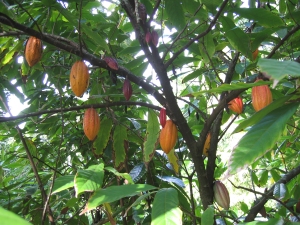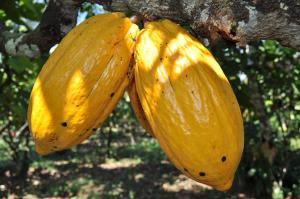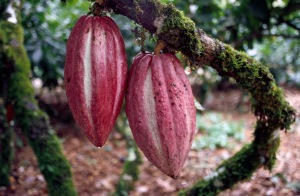There are few items in the world more universally loved than chocolate. No matter where you go chocolate is usually somewhere close by. Through advertisements, word of mouth and the simple smells of the local bakery chocolate has come to encompass society’s everyday life. The substance has been consumed, advertised and mystified to the point that it is closer to universal concept than food. However, as loved as chocolate is, most people forget (or even do not know) chocolate’s origins and original tastes. This is because as chocolate evolved, popular culture has forgotten the original tastes that chocolate once had and enhanced. A key period in this shift is chocolate’s development from Mesoamerican product to European icon in the 17th century. In an effort to increase popularity and cultivate to European palates the changes made to chocolate stripped away a portion of its original Mesoamerican identity. In analyzing its change in ingredients, recipes and culture, one can see that, chocolate went through an appropriation, brought about by European palates in an effort to make chocolate a European product. This happened to the point that chocolate’s original form and taste became, and still is, barely recognizable as Mesoamerican.
Mesoamerican vs European Recipes
In order to understand the change in chocolate it is important to first understand its origin and original flavor profile. Before colonialism, chocolate had begun to reach its peak popularity within the Aztec empire, being used for a myriad of things, from religion to, celebrations. However, unlike the tastes of the chocolate known today the Mesoamericans flavored their chocolate using the ingredients that naturally grew in their environment like chilis and maize(Martin, Sampeck). This added a fresh taste to the chocolate; one that was also “earthy” and sometimes spicy due to the use of plants and natural ingredients in chocolate recipes. This use of their natural environment can be seen in Mesoamerican recipe’s like Lacandón Sacred Chocolate Drink, a recipe recorded by colonists after their arrival.

The Lancandón Drink recipe shows the Mesoamerican palate to be focused on extracting maximum flavor from the cacao while enhancing such flavor with natural grown herbs and plants and not being intimidated by chocolates innate bitterness This confectionary style is seen not as often in the present days, as large candy companies like Hershey’s and Mars create chocolate that is focused more on sweetness than enjoying the bitterness of cacao.
In comparison, upon arrival to Mesoamerica, most Europeans found the taste of the chocolate to be too bitter and the drink made from it uncomfortably thick and cold (Martin, Sampeck). This was because chocolate was an acquired taste for European palates, which were not used to the flavorings brought by unknown Mesoamerican plants and fruits. The European palate was more tailored towards sugar and spices. While those in Mesoamerica grew to like the Aztec style of chocolate and chocolate drink, in order to make chocolate profitable in Europe, the Mesoamerican flavor profile of chocolate had to be “translated” so that it could be delicious to European palates and compete with also popular newcomers tea and coffee. This prompted them to make changes to the Mesoamerican recipes so that they were more familiar to the European tastes and therefore enjoyable. Such changes can be seen in the modified recipes such as that of Antonio Colmenero De Ledesma.

As can be seen in Ledesma’s recipe the European chocolate recipes kept a few of the Mesoamerican originating ingredients, like mecaxochitl, and chilis, but also added sugar, vanilla, cinnamon and hazelnuts. This added the sweetness to the chocolate that is craved by European palates. This recipe also came with an advisory not to drink it cold (as he “Indians” did), as it was thought to cause stomach aches (Coe,134). This ultimately led to the concept of hot chocolate that we know and love today.
Modeling Flavor Profiles
There are several reasons why these ingredients were added. Such spices were the most abundant within Europe, while the original Mesonamerican ingredients were less prevalent. In order to better visualize the difference in flavor profiles between the two groups two histograms can be seen below which separate the main ingredients of European and Mesoamerican chocolate.


In comparing these two charts, the only similar ingredients between the two is sugar, which was used in a much larger amount by the Europeans. The Mesoamerican flavor profile features ingredients native to Central America like achiote, a natural food coloring grown in Central America, and xochinacatzli, a highly sought-after flower that is known for its unique spicy odor and taste (Schwattzkopf, Sanpeck 83). An interesting point in the comparison of these two charts is the addition of milk in chocolate as the Mesoamericans did not have access to it before the arrival of the Europeans. This addition is a good example of the Europeans changing the ingredients in order to fit their palates and entice the European market. This translation from Mesoamerican to European palates is not the sole factor in the wandering away from the Mesoamaerican origin. However, over time the translation for European palates became a transition of chocolate being seen as a Mesoamerican substance to a European substance, leading to the subversion of the Mesoamerican flavor profile and ultimately, after colonization of North America by Europe, the type of chocolate we see today.

Importance of Noting Change
This is why the initial difference in flavor profiles is important. It is necessary to understand because the walk away from Mesoamerican ingredients in the 17th century was the beginning of a pattern of people innovating chocolate but failing to remember its origins. This can even be seen today as presently chocolate still mostly models its European modifications but has also added its own modifications. An increase in sugar, preservatives and flavors like mint and caramel, push chocolate even further away from its origins. Today most organizations brand Chocolate that uses Mesoamerican flavors as Aztec or Mayan, not to harken back to the origins of the substance, but to increase its mystic attractiveness (figure above). This is done instead of recognizing that these Mesoamerican tastes were the original methods of chocolate consumption. The idea is not to analyze a single historical context but notice a continuous pattern of society forgetting the origins of the products/events that are around them. While such arguments may not be as dire as other current world problems it is important that we develop a habit of correcting history and giving credit where credit is due to the individuals and groups of people who have contribute to the society we enjoy so much today.
Sources
Coe, S. (2007). The true history of chocolate (Revised [and updated ed.]. ed.). New York: Thames and Hudson. Print
Sampeck Katheryn & Jonathan, Thayn, “Translating Tastes: A Cartography of Chocolate Colonialism.” (2017) pp. 72-99. Web.
Martin, Carla and Sampeck, Kathryn. “The Bitter and Sweet of Chocolate in Europe.” 2016 pp. 37-60. Web.
Image Credits
Coe, S. (2007). The true history of chocolate (Revised [and updated ed.]. ed.). New York: Thames and Hudson. Print.
Martin, Carla and Sampeck, Kathryn. “The Bitter and Sweet of Chocolate in Europe.” 2016 pp. 37-60. Web.




You must be logged in to post a comment.